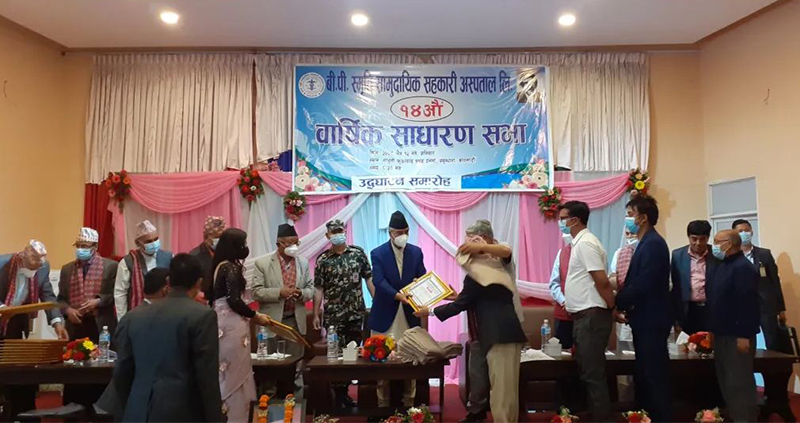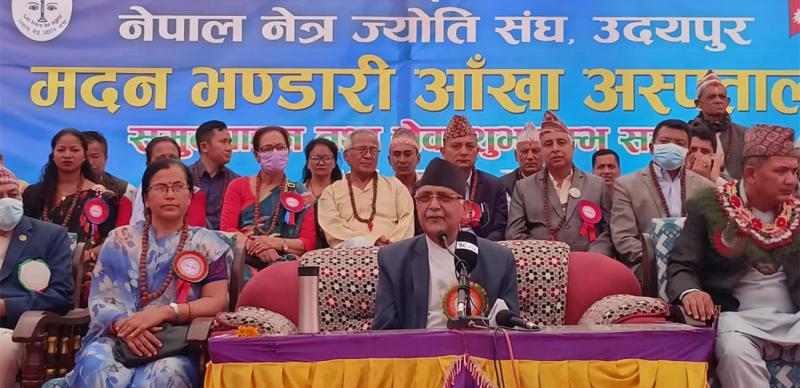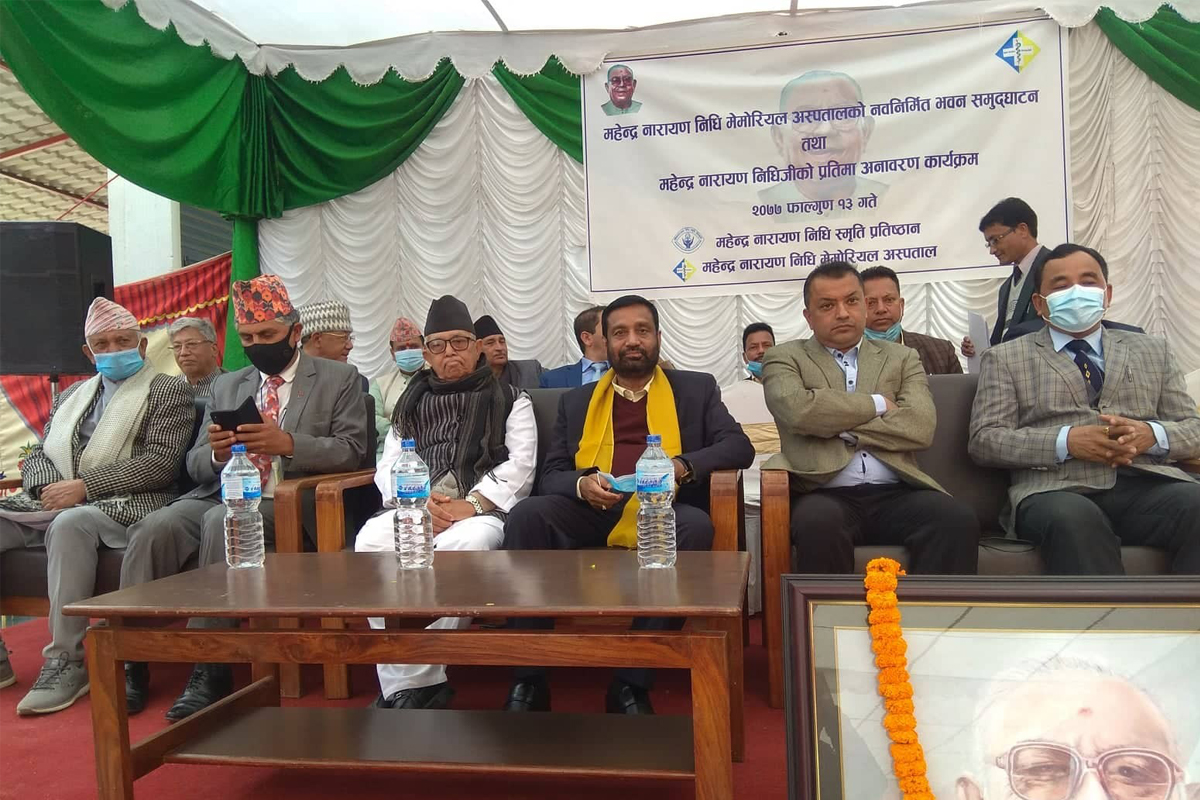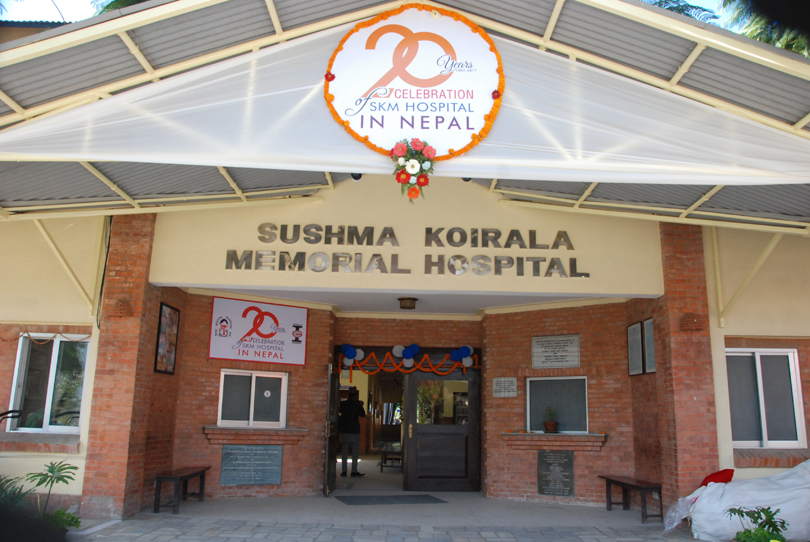While public hospitals are reeling under lack of human and economic resources, the government is donating large amounts of funds to community hospitals, many of which haven’t submitted reports of how they spend the funds.
Sagar Budhathoki |CIJ, Nepal
The National Kidney Center in Banasthali, Kathmandu provides dialysis treatment to kidney patients. The center provides free dialysis to patients over 75 years of age and for that, it receives yearly donations from the Ministry of Health and Population.
Between 2018 and 2022, the center received a donation of Rs 125 million. In the fiscal year 2019-20, the center’s mother organization, Healthcare Foundation, received Rs 60 million in donations.
How the center spent the donation meant to serve the target group remains a mystery; neither has it submitted a detail of its expense nor has the ministry asked it to furnish it. This is despite a mandatory provision to submit the expenditure report of such donations.

A program of BP Smriti Community Cooperative Hospital Shay Congress President Bahadur Deuba.
Until nine years ago, there were barely a couple of organizations who wouldn’t submit expense reports of donations. Today, there are dozens. Health Ministry records show that in the fiscal year 2013-14, three organizations that had received a total of Rs 120.7 million in donations didn’t submit their expense report. But the ministry doesn’t have a record of how many organizations had received donations in that fiscal year.
In fiscal year 2021-22, as many as 34 organizations that had received donations didn’t submit their expenditure report. They had altogether received Rs334.7 million. This is about 26 times more than the donation amount provided to such organizations just eight years ago.
To prevent the misuse of the donation amount provided to community hospitals, the health ministry issued a directive in 2073BS. Organizations receiving the amount have to submit a detailed report of how the amount was spent and under what heading to the ministry every year. If they don’t, they won’t receive a donation next year. But organizations such as the Kidney Center haven’t fulfilled that criteria, yet they are receiving the donations continuously.
Another such organization that hasn’t submitted its expense report but has been receiving donations is Martyrs Memorial Community Hospital Development Center, Nawalparasi. The center received Rs9.041 million in donations in 2072 BS but the ministry is unaware about how it spent that amount. But the center again received a donation of Rs3.3 million in 2074 BS and a whopping Rs 20 million in 2078BS.
The Banepa-based Reiyukai Eiko Masunaga Eye Hospital has also received donations repeatedly but hasn’t submitted an expense report. In fiscal year 2074-75BS, the hospital received Rs3.756 million in donations. The next year, it received Rs 15 million in donations to purchase various equipment. The hospital hasn’t submitted a report of its expenses for both years, and yet, it received a donation of Rs 5 million in the fiscal year 2078-79BS.
The Rajahar-based Community Nature Cure Hospital also hasn’t submitted its expense report of the Rs18.325 million donation it has received in various years.
Those with access remain the beneficiaries
Majority of those organizations that have received donations but haven’t submitted reports of expenses have connections to political parties and leaders. The Madan Bhandari Eye Hospital in Udayapur, for instance, hasn’t submitted the expense details of the Rs 10 Million donations it received in the fiscal year 2021-22 and 2022-23.
The hospital was inaugurated on March 25, 2022, when KP Sharma Oli was the prime minister. The Netra Jyoti Sangh, Udyapur runs the hospital. The Sangh’s chief Bhagwat Raut was contesting for Mayor of Triyuga Municipality with a CPN-UML ticket.

The then Prime Minister KP Sharma Oli at the inauguration of Madan Bhandari Eye Hospital.
The Sushma Koirala Memorial Hospital, Sankhu received a donation of Rs3.5 million in the fiscal year 2018-19 and without submitting its expense report, received further Rs 150 million in 2021-22 and Rs334.7 million in 2022-23. The hospital has affiliations with Nepali Congress leader Sujata Koirala and is run by the Sushma Koirala Memorial Trust.
In the fiscal year 2017-18, the Jhalanath Khanal Medical Science Academy, based in Lalbandi, Sarlahi, received a donation of Rs8.5 million to rear snakes. The academy did submit its report ceding to pressure from the ministry but the work is yet to begin. Even the federal, provincial and local governments have disbursed the budget for the institution.
A 2017 directive formulated by the health ministry has the provision that community hospitals based in urban areas, including in Kathmandu Valley, are not eligible to receive donations.
The clause 3 of the directive says that only community hospitals that are based outside of city areas, have at least 15-bed capacity and are authorized by the agency concerned can receive donations. But the same year the directive was issued, the Mahendra Narayan Nidhi Memorial Hospital, based in Kathmandu’s Gaushala, received a donation of Rs 30 million.
Officials working at the health ministry then say that the then deputy prime minister and home minister Bimalendra Nidhi had pressured them to provide donations to the hospital that lies within the Kathmandu Metropolitan City. The hospital, established in 2011, has a 55-bed capacity. Bimalendra, a prominent Congress leader, is the son of Mahendra Narayan Nidhi.
Also after the directive, the Sitapaila-based Manmohan Community Hospital, operated by then UML lawmaker Rajendra Pandey, received Rs 30 million in donation and the BP Memorial Community Cooperative Hospital, operated by Congress leader Dr Shekhar Koirala, received Rs 12 million in donation. To grant them donations, even the directive itself was amended.
Until the first amendment to the directive in January, 2017, it had the provision that barred donations to community hospitals within metropolises and sub-metropolis. But by March that year, the directive was amended to erase the words metropolises and sub-metropolis. The Sushma Koirala Memorial Hospital took advantage of this amendment and received Rs3.5 million in donation and the Orthopedic Hospital in Jorpati Rs3.14 million. The former had already received Rs 10 million prior to that, by breaching the directive’s provision.
The Siraha-based Chandra Narayan Yadav Memorial Trust, named after the veteran Congress leader, too hasn’t submitted its expense report of donations. Yadav’s wife and Congress’s former treasurer Seeta Devi Yadav serves as the trust’s custodian. The trust received Rs 10 million for the building’s construction in fiscal year 2019-20 but it hasn’t submitted a report of how that amount was spent.
Though the ministry knows the mandatory expense report is not submitted, it continues to grant donations to the trust; in fiscal 2020-21, it provided Rs 20 million, in 2021-22, Rs10 million and in the current fiscal year, it has provided Rs26 million to the trust. But the ministry hasn’t asked how this Rs56 million in donation has been spent.
The Rautahat-based Gajendra Narayan Singh Memorial Academy hasn’t submitted the report of Rs 20 million donation it received in 2022-23. The hospital, which is authorized to run a 50-bed establishment from the provincial government, was inaugurated in April 2022 but hasn’t yet come into full operation. Anil Jha, a former lawmaker and leader of Loktantrik Samajbadi Party, is affiliated with the academy. Jha says that he was able to provide government donations to the academy because he was a lawmaker.
“We managed to receive donations after much effort while I was a lawmaker but we haven’t been able to run the hospital well now,” he says. Once the hospital is run well, it will submit the expense report of donation, Jha added.

Congress leaders Bimalendra Nidhi, Gagan Thapa and others at the inauguration program of Mahendra Narayan Nidhi Memorial Hospital.
The Pokhara-based Bindhyabasini Nature Hospital received Rs 10 million in donation in the fiscal 2011-23 but it too hasn’t submitted its expense report. The Bindhyabasini Religious Area Development Trust had received the donation to run a 100-bed hospital.
The hospital was said to start operation from mid-January this year, but it hasn’t started yet. Ganesh Bahadur Shrestha, of the business group Lakshmi Samuha, is the Trust’s president. Shrestha says they are still in the process of submitting the expense report. Meanwhile, an official from the health ministry says that the prime minister’s office had pressured the ministry to grant donations to the trust. Sher Bahadur Deuba was the prime minister then.
Dadheldhura’s Api Community Hospital is another example. In the fiscal year 2017-18, the hospital received Rs20.46 million in donations, but after the health ministry team reached the hospital after a year, it didn’t have a record of a single patient visiting it. The hospital lies only about 1500 meters from the sub-regional hospital so it is ineligible to receive donations. But chair of CPN-UML Dadeldhura and businessman, Prakash Saud, was involved in the hospital and it received donations on his back.
Ministry officials say that various hospitals carrying the names of political leaders receive donations after parties close to them come into power.
As such, the Udayapur-based Madan Bhandari Eye Hospital has received Rs 10 million, the Sitapaila-based Manmohan Memorial College and Teaching Hospital Rs 15 million, the Dakshinkali-based Manmohan Community Hospital Rs 5 million and the Lokanthali-based BP Eye Foundation Rs 6 million. None of them have submitted expense reports.
The Nawalparasi-based Martyrs Memorial Hospital, which has received donations repeatedly but hasn’t submitted an expense report, is chaired by Nimananda Neupane, who is the consultant of UML’s district committee. Congress leader Madhu Acharya is board chair of Banepa-based Masunaga Eye Hospital. Hiramani Sharma, general secretary of the hospital, doesn’t hide the fact that it received donations because of its political connection. “I don’t think there’s any hospital that has received a donation after fulfilling the criteria,” he says. “Everyone receives it on the basis of proximity to power.”
Institutions with no relation to health getting donation
The second edition of the directive about providing donations to community hospitals states that a notice should be published at a daily newspaper and the ministry’s website calling for potential beneficiaries. To evaluate the applications, a committee should be formed in the leadership of the chief of policy, plan and international coordination department at the ministry. The committee will then select the beneficiaries of donation.
The directive further mentions that hospitals run as private limited companies, cooperatives and for-profit institutions are not eligible for donations from the government. Then those who have received donations should submit the report on how the donation amount is used and the progress of the stated work within 15 days of the quarterly period and another report on the physical progress of the work within 90 days of the fiscal year’s end and an audit report to the ministry. If the beneficiary companies go against the directive, they will be blacklisted and be punished as per existing laws.

From left, Bimalendra Nidhi, Sita Devi Yadav, Kedar Narsingh KC and Badri Pandey.
But this criteria is being made a mockery of, evinced through the Auditor General’s report itself; each report since 2016 has raised questions over the donation process. The 59th Auditor General’s report published in 2022 has also said the donation provided to community hospitals follows a faulty process.
Even more surprising is the fact that even institutions that are not directly related to health at all are also receiving donations. Among them is the Samsad Rashtriya Manch for Population and Development.
The organization, which in no way deals with health, received Rs1.8 million in fiscal year 2021-22 and Rs5 million in 2022-23. Neither has it submitted the report of its expenditure. The organization, which is based in Kathmandu, has former UML lawmaker Dil Kumari Rawal Thapa as chair, Nepali Congress assistant general secretary Badri Pandey the deputy chair, and UML’s secretary Bhisma Adhikari the secretary general.
Nijamati Karmachari Wives Association, another organization unrelated to health, has received Rs2 million in fiscal year 2022-23. The association is headed by the government chief secretary’s wife. The Nepal Medical Association has also received donations yearly. It received Rs9.93 million in 2018-19 and Rs1.5 million in 2022-23. It too hasn’t submitted the expense report.
Sanjeevani Sewa Sangh is another such organization. The organization took away Rs5.3 million in fiscal years from 2019 to help the needy patients, but it hasn’t submitted a report of how the donation is spent.

Sushma Koirala Memorial Hospital at Sankhu.
Ayurveda Chikitsa Parishad Nepal has taken Rs5 million since 2021 and hasn’t submitted the report. In 2021-22, the Nepal Ambulance Sewa received Rs6.5 million and Rs 10 million in 2022-23.
The Apex Body for Eye Health, which is headed by the health ministry’s secretary, has received Rs55.2 million since 2019 and hasn’t submitted its expense report.
After knowing that this organization hasn’t done anything out of donation money, the ministry has stopped providing it, according to Dr Krishna Poudel, chief of the ministry’s policy and plan department. “Though many organizations haven’t submitted expense reports, only a few have embezzled the donation,” he said. “It’s necessary to regulate that.”
Former health secretary Dr Senendra Uprety said that ministry officials might be working in bad faith to provide donations to organizations that haven’t submitted expense reports. He claims that when he was the secretary for 11 months, he received a lot of pressure to provide donations to certain organizations but he didn’t yield to it. “The pressure is there constantly but the administrators should not yield to it,” he says.
Former chief specialist of health ministry Mahendra Shrestha says that the directive was introduced to control random distribution of government donations. “But it wasn’t followed,” he says.
Dr Poudel insists that donation was provided to some organizations that have been doing good work even if they don’t meet the criteria of the directive. Moreover, he concedes that the ministry has provided donations to some organizations ceding to pressure.
“Organizations that are doing good work at serving the people may not meet the criteria and if we stop providing them donations, the people will bear the brunt,” Poudel says. “So the directive is also not being followed for practical reasons.”
Khemraj Regmi, former chief of Transparency International Nepal, says that breaching the directive goes against law. “Breaching the directive in bad faith is a form of corruption,” he says.
Another senior official at the health ministry says that they are always pressured to provide donations to certain organizations that have political connections. According to the official, most of the pressure comes from the Ministry of Finance and the Prime Minister’s office. “If anyone stops donations to certain organizations, then that official might be posted somewhere else,” the official says.
Mismanaged healthcare system
While the ministry has donated various community hospitals run by assorted NGOs, it has failed to invest enough on public hospitals.
In public institutions like Bir Hospital, Teaching Hospital and Human Organ Transplant Center, around 10,000 patients have to wait for their turn for surgery yearly for lack of medical equipment and well-equipped operation theaters. In the Center, as many as 7,000 patients are currently waiting for their turn to transplant their kidneys, according to the hospital’s director Dr Pukar Chandra Shrestha.

From left Anil Jha, Dilkumari Thapa Rawal (Parvati), Jhalnath Khanal and Rajendra Pandey.
In the rural areas, the human resource crunch is so severe that there’s nobody who can even run a ventilator. Myagdi’s Beni Hospital, for instance, needs three doctors and 12 staff nurses to run its 5-bed ICU but it currently has none.
Dolakha’s Charikot Primary Health Center has five ventilators, two PICUs, and a six-bed HDU, but for lack of human resource, they remain unused, says medical superintendent Dr Binod Dangal.
In Manang District Hospital, two ventilators remain unused. While Karnali Province’s 10 districts have ICU beds and ventilators, only those in Surkhet-based provincial hospital and Karnali Health Science Academy are currently in use.
According to the Global strategy on human resources for health: Workforce 2030, at least 4.45 human resources in health is required per 1000 people. But in Nepal, the ration is only 1.94.
According to the National Strategy on Human Resources for Health, on average, only 71.3 percent manpower is deployed around the country. The strategy points out that the country is short of at least 41,000 health workers to cure patients in normal situations.
Service delivery is hugely affected as many public hospitals remain under equipped and short of funds. On the other hand, the government is distributing donations haphazardly going against its own directive.
Dr Sharad Onta, a public health expert, says thousands of patients are deprived of services yearly because the state hasn’t invested enough on expanding manpower and smoothening delivery. “The number of manpower from 10 years ago can’t handle the demand now,” he said. “The ministry should evaluate whether its investment is utilized or not.”
The Infant and Young Child Nutrition Policy 2073BS points out that only if the government increases the investment by five percent can it achieve 90 percent of its target set on the infant and maternity health sector. But because the government’s investment is misplaced, the country’s health indicators are pitiful. According to the health ministry’s Nepal Demographic and Health Report, 2022, of every 1000 children born, 33 below five years of age, 28 below one and 21 below 28 days of age die every year.
Baburam Marasini, a public health expert, says that to eradicate the existing inequality in the health sector, the government should invest enough and monitor it.
Dr Shivaraj Adhikari, a public health economist, says that the common people are forced to take loans to seek medical service while the government is bent on providing donations at random instead of improving the public health sector. Because of the mismanaged healthcare sector, as many as 500,000 Nepalis are pushed below the poverty line every year and as many as three million face economic hardship, according to a World Health Organization report.
Dr Roshan Pokharel, the health secretary, says that those who have received donations previously keep on pressuring the ministry officials. “As for me, I won’t forward any file that belongs to organizations that haven’t met the criteria of the directive,” he said.
BY THE NUMBERS:
In the fiscal year 2073-74 BS, as many as 23 organizations had received a donation of Rs 333.8 million; five organizations didn’t submit the expense report of Rs41.2 million donations they had received. The next fiscal, the health ministry had distributed a total of Rs 837.7 million as donation. Of which, 30 beneficiaries didn’t submit reports of Rs 100 million donation.
In the fiscal year 2075-76, eight institutions that had received Rs 162.8 million in donations didn’t submit expense reports; the next year, nine organizations didn’t submit reports of Rs138.7 million donation. Likewise, in the fiscal year 2077-78, 13 organizations that had received Rs 83.3 million in donations didn’t submit their report of expenses. Nobody has questioned them yet.
Between the fiscal years 2072-73 and 2078-79, the ministry has distributed Rs2 arab 86 crore 30 lakh 94 thousand and two hundred seventy eight in donations. Of which, expenses of over Rs87 crore 36 lakh remain unaccounted for. The number of organizations not submitting reports of their expense of donation amount is increasing by the year.



